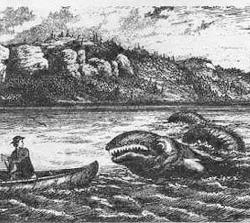Part I appeared in the previous issue of SpecGram.
Noams: Small, wizened, earth-
Omkèlé-Bmèbmé: A giant sauropod linguocryptid of Africa. It is said to be so horrible that it causes involuntary metathesis in those who see it.
 Onomatopogo |
Phoerynx: A linguolegendary bird of the Mediterranean region. The small bird would sneak into a person’s oral cavity and hide near the back of the throat. When the person became angry, the phoerynx would explode out of the mouth in a burst of hurtful fiery words, killing the phoerynx and usually hurting those who heard the cruel words. So fiery were the words that a few ashes would fall to the ground around the exchange, and from these ashes another phoerynx would be born.
Polyglossasus: A winged horse of Ancient Greece said to give its rider—if any could tame it—the power to speak any and all languages.
Pragmatean Bed: A device used by evil Linguiwizard Pragmates to force any meaning onto any sentence. For example, the sentence “His son ate oatmeal at home”, could be forced by powerful pragmatic contextual magics—the father, who hated oatmeal, had told the son that he could only eat it at home “over my dead body”—to mean “The father has died.”
Quetzlnhlxtzlchctlcoātl: The Mesoamerican god of difficult-
 Septuple Ligature |
Slippy Hollow: A small town in upstate New York, on the west bank of the Hudson River. On foggy nights, the headless body of William Archibald Spooner is said to roam the town, sneaking up behind townsfolk and gurgling, “You have hissed all my mystery lectures!”
 Spring-Tongued Jack |
/sʃfɪnxh/: A hideous Greek or Egyptian creature with the face of a woman, the body of a linguist, and the wings of an undergraduate. They have great wisdom in all matters concerning fricatives, but will only share it with those who can answer their riddles.
Ðor: The red-
 Θωθ |
Tricorn: A very rare breed of syntactic horse of which stories are told throughout the northern hemisphere. It allows three-
Verbal Vampire: A non-
 Vowelkyrie |
Vowelkyries: Supernatural Norse female linguist-
Whyvern: A two-
Heraldic Whyvern holding a
Fleur-de-Point-d’Interrogation
Will O’ the Whisper: Far-
Woperdaughterticore: A monster of the Malaysian and Indonesian forests, with the body of a red lioness, a tail tipped with a ball of spikes, and the face of an etymologically-
Ŷĝĝḓřấŝíìλ: The Norse Binary Tree of the Word, from which all structure in language comes. It has roots reaching into the Well of Phonemes, the Spring of Meaning, and the Syntax of all Rivers.